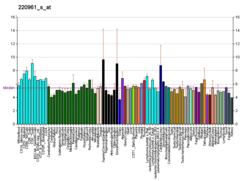TBRG4
Transforming growth factor beta regulator 4 (TBRG4), also known as cell cycle progression restoration protein 2 (CPR2) and FAST kinase domain-containing protein 4 (FASTKD4), is a protein that in humans is encoded by the TBRG4 gene on chromosome 7.[5][6][7] This protein is part of the FASTKD family, which is known for regulating the energy balance of mitochondria under stress and cell cycle progression.[8][9] TBRG4 is involved in cell proliferation in hematopoiesis and multiple myeloma.[10][11]
Structure
TBRG4 shares structural characteristics of the FASTKD family, including an N-terminal mitochondrial targeting domain and three C-terminal domains: two FAST kinase-like domains (FAST_1 and FAST_2) and a RNA-binding domain (RAP).[8][9] The mitochondrial targeting domain directs TBRG4 to be imported into the mitochondria. Though the functions of the C-terminal domains are unknown, RAP possibly binds RNA during trans-splicing.[8] TBRG4 also contains multiple putative leucine zipper domains.[6]
Function
As a member of the FASTKD family, TBRG4 localizes to the mitochondria to modulate their energy balance, especially under conditions of stress. Though ubiquitously expressed in all tissues, TBRG4 appears more abundantly in skeletal muscle, heart muscle, and other tissues enriched in mitochondria.[8] TBRG4 also localizes to the bone marrow (BM), where it functions in hematopoiesis by inducing IL-6 and VEGF secretion, which then stimulate cell proliferation and angiogenesis. However, it inhibits immunoglobulin secretions by normal B cells.[10]
Clinical significance
The involvement of TBRG4 in hematopoiesis links it to multiple myeloma (MM), which stems from malignant proliferation of plasma cells in the bone marrow.[10] High expression of TBRG4 has been linked to enhanced cell proliferation and poorer outcome; thus, downregulation of its expression may contribute to reducing tumor growth by arresting cell cycle progression.[11]
References
- GRCh38: Ensembl release 89: ENSG00000136270 - Ensembl, May 2017
- GRCm38: Ensembl release 89: ENSMUSG00000000384 - Ensembl, May 2017
- "Human PubMed Reference:". National Center for Biotechnology Information, U.S. National Library of Medicine.
- "Mouse PubMed Reference:". National Center for Biotechnology Information, U.S. National Library of Medicine.
- UniProt: Q969Z0
- Edwards MC, Liegeois N, Horecka J, DePinho RA, Sprague GF, Tyers M, Elledge SJ (Nov 1997). "Human CPR (cell cycle progression restoration) genes impart a Far- phenotype on yeast cells". Genetics. 147 (3): 1063–76. PMC 1208234. PMID 9383053.
- "Entrez Gene: TBRG4 transforming growth factor beta regulator 4".
- Simarro M, Gimenez-Cassina A, Kedersha N, Lazaro JB, Adelmant GO, Marto JA, Rhee K, Tisdale S, Danial N, Benarafa C, Orduña A, Anderson P (Oct 2010). "Fast kinase domain-containing protein 3 is a mitochondrial protein essential for cellular respiration". Biochemical and Biophysical Research Communications. 401 (3): 440–6. doi:10.1016/j.bbrc.2010.09.075. PMC 2963690. PMID 20869947.
- Yeung KT, Das S, Zhang J, Lomniczi A, Ojeda SR, Xu CF, Neubert TA, Samuels HH (Jun 2011). "A novel transcription complex that selectively modulates apoptosis of breast cancer cells through regulation of FASTKD2". Molecular and Cellular Biology. 31 (11): 2287–98. doi:10.1128/MCB.01381-10. PMC 3133243. PMID 21444724.
- Sevcikova S, Paszekova H, Besse L, Sedlarikova L, Kubaczkova V, Almasi M, Pour L, Hajek R (Apr 2015). "Extramedullary relapse of multiple myeloma defined as the highest risk group based on deregulated gene expression data" (PDF). Biomedical Papers of the Medical Faculty of the University Palacký, Olomouc, Czechoslovakia. 159 (2): 288–93. doi:10.5507/bp.2015.014. PMID 25877407.
- Sarasquete ME, Martínez-López J, Chillón MC, Alcoceba M, Corchete LA, Paiva B, Puig N, Sebastián E, Jiménez C, Mateos MV, Oriol A, Rosiñol L, Palomera L, Teruel AI, González Y, Lahuerta JJ, Bladé J, Gutiérrez NC, Fernández-Redondo E, González M, San Miguel JF, García-Sanz R (Oct 2013). "Evaluating gene expression profiling by quantitative polymerase chain reaction to develop a clinically feasible test for outcome prediction in multiple myeloma". British Journal of Haematology. 163 (2): 223–34. doi:10.1111/bjh.12519. PMID 23952215.
Further reading
- Maruyama K, Sugano S (Jan 1994). "Oligo-capping: a simple method to replace the cap structure of eukaryotic mRNAs with oligoribonucleotides". Gene. 138 (1–2): 171–4. doi:10.1016/0378-1119(94)90802-8. PMID 8125298.
- Suzuki Y, Yoshitomo-Nakagawa K, Maruyama K, Suyama A, Sugano S (Oct 1997). "Construction and characterization of a full length-enriched and a 5'-end-enriched cDNA library". Gene. 200 (1–2): 149–56. doi:10.1016/S0378-1119(97)00411-3. PMID 9373149.
- Nagase T, Ishikawa K, Suyama M, Kikuno R, Hirosawa M, Miyajima N, Tanaka A, Kotani H, Nomura N, Ohara O (Feb 1999). "Prediction of the coding sequences of unidentified human genes. XIII. The complete sequences of 100 new cDNA clones from brain which code for large proteins in vitro". DNA Research. 6 (1): 63–70. doi:10.1093/dnares/6.1.63. PMID 10231032.
- Simpson JC, Wellenreuther R, Poustka A, Pepperkok R, Wiemann S (Sep 2000). "Systematic subcellular localization of novel proteins identified by large-scale cDNA sequencing". EMBO Reports. 1 (3): 287–92. doi:10.1093/embo-reports/kvd058. PMC 1083732. PMID 11256614.
- Rival-Gervier S, Thépot D, Jolivet G, Houdebine LM (May 2003). "Pig whey acidic protein gene is surrounded by two ubiquitously expressed genes". Biochimica et Biophysica Acta (BBA) - Gene Structure and Expression. 1627 (1): 7–14. doi:10.1016/s0167-4781(03)00051-4. PMID 12759187.
- Beausoleil SA, Villén J, Gerber SA, Rush J, Gygi SP (Oct 2006). "A probability-based approach for high-throughput protein phosphorylation analysis and site localization". Nature Biotechnology. 24 (10): 1285–92. doi:10.1038/nbt1240. PMID 16964243.
- Ewing RM, Chu P, Elisma F, Li H, Taylor P, Climie S, McBroom-Cerajewski L, Robinson MD, O'Connor L, Li M, Taylor R, Dharsee M, Ho Y, Heilbut A, Moore L, Zhang S, Ornatsky O, Bukhman YV, Ethier M, Sheng Y, Vasilescu J, Abu-Farha M, Lambert JP, Duewel HS, Stewart II, Kuehl B, Hogue K, Colwill K, Gladwish K, Muskat B, Kinach R, Adams SL, Moran MF, Morin GB, Topaloglou T, Figeys D (2007). "Large-scale mapping of human protein-protein interactions by mass spectrometry". Molecular Systems Biology. 3 (1): 89. doi:10.1038/msb4100134. PMC 1847948. PMID 17353931.





